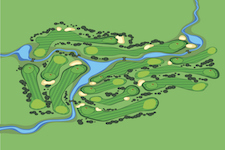HOLE 1:
GAME OVERVIEW
Golf is much more than a game. It's a unique culture that you join the moment you enter the clubhouse, and like any sports culture, golf has a vocabulary all its own. Understanding how the game is played and learning the lingo will help you get the most out of your lessons. We'll cover both topics in this section so you can stroll up to the first tee with confidence. Welcome to the wonderful world of golf!
HOW THE GAME IS PLAYED
Anatomy of the Golf Course
Golf is one of the few games that does not require a standardized playing area, but it is governed by an extensive set of rules. The game of golf is played on a COURSE, which is made up of a series of HOLES. Golfers play in groups of four people or fewer. You play hole by hole (in order) and can choose to either walk or ride in a GOLF CART.
A standard game of golf consists of 18 holes numbered 1 through 18. Typically, holes 1 through 9 are referred to as the FRONT NINE and holes 10-18 are referred to as the BACK NINE. The 19TH HOLE is one of our favorites! This is the post-round hot spot, typically in the clubhouse, where golfers enjoy refreshments and socialize. This is also where deals are sealed and lasting relationships develop.
Each hole has several locations where you can choose to start and a putting area (with a hole) where you end. In between, a course will include other types of terrain, which makes each golf course unique.
Play for each hole begins at the TEE BOXES or TEE AREAS and they vary in distances to the hole. The tee box is usually a square area with shorter grass identified by a set of TEE MARKERS, which are color-coded. Each player determines which color or set of tees they plan to use during the game, and that is where they start playing on each hole. The most forward tee box is where new and learning players often begin, while more advanced players usually select a box further back.
As a new golfer, it is best to avoid courses with a lot of FORCED CARRIES from the tee box. On these more challenging holes, the ball must fly up and over an unplayable area such as a ravine, creek or pond in order to land on playable ground. If you are playing for recreation, it is perfectly acceptable to start your game on the other side of the danger to make the hole less difficult.
Each hole features a FAIRWAY, which is the best path to the hole (and where you want to aim the ball). The grass on the fairway is cut short so conditions are easier for hitting the ball. When the fairway takes a sharp curve to the hole, it is called a DOGLEG.
On either side of the fairway is the ROUGH, which contains taller grass that is a bit more difficult to play from.
HAZARDS are areas of the course you want to avoid! A WATER HAZARD is any body of water such as a pond, lake or creek. A SAND BUNKER or SAND TRAP is a large hole filled with sand that is placed around the course to add some difficulty.
The GREEN is the small manicured area of grass where you will find the hole. The hole is marked by a FLAGSTICK. Surrounding the green is the FRINGE, which is a ring of grass cut just a tad higher.



Object of the Game
The object of golf is to hit the ball from the tee area into the hole in as few STROKES as possible. Players use a set of clubs to advance the ball over a variety of ground conditions and distances.
By stringing together a number of holes you keep score and play a ROUND of golf. Each hole is assigned a PAR, which is the number of STROKES a professional golfer needs to get the ball into the hole. A typical REGULATION COURSE is made up of a combination of par 3, par 4 and par 5 holes. Par 3 indicates a shorter distance to the hole and par 5 indicates the longest distance to the hole. Many beginners like to play on shorter PAR 3 courses, which is a course made up of only par 3 holes.
You may also hear the term EXECUTIVE COURSE, which is made up of par 3’s and 4’s to keep the total length of the course shorter and therefore quicker to play.
Competitive golfers play for the lowest score to win and use par as the score to meet or beat on each hole. The SCORE is the total number of strokes the golfer takes on each hole to get the ball into the hole.
You may hear different terms to describe that score in relation to par on that hole.
BOGEY – One stroke over par
DOUBLE BOGEY – Two strokes over par
TRIPLE BOGEY - Three strokes over par and so on.
If you hear someone describe herself as a double bogey golfer, this means she typically shoots 2 over par. To keep a good pace of play she will often pick up her ball when she reaches this score and has not made it into the hole.
When you play with better golfers you will hear these terms.
BIRDIE – One under par
EAGLE – Two under par
ACE – A hole in one – and if you make one of these, be prepared to follow tradition and buy everyone a drink when you end up in the clubhouse!



How to Play a Round
The traditional round of golf is made up of 18 holes. To cater to our busy lives, more courses offer special pricing to play 9 holes. Women on Course has been working with courses to set up shorter, one-hour rounds of four holes that can be enjoyed at the end of the work day.
Golfers in groups of four or fewer people play the course together. Upon arrival, the first stop is typically the PRO SHOP, where you check in and pay for your round. Next, your group will report to the first hole where a STARTER is typically stationed nearby. The starter will review specific instructions relating to the course, such as where golf carts can be driven, the location of rest rooms and the PIN PLACEMENT for the day. This is the area of the green where you will find the hole. This information is important for better players to calculate distances and make good club choices.
To begin the round, each player decides which tee box, identified by colored markers, she will start from. Players will start from that color tee box on every hole. The player using the furthest back tee box goes first. Each player will take their first shot from the tee box, which is called the DRIVE. After everyone takes a turn, the player who is furthest from the hole takes their next shot. Play continues in this order until everyone gets their ball in the hole.
There are many team formats, which is a great way for beginners to experience playing for score. The most common is a SCRAMBLE, which is a popular format for charity and corporate outings. You'll learn how to play a scramble in Hole #5.



HOLE 1: GAME OVERVIEW
HOW THE GAME IS PLAYED
◇ Anatomy of a Golf Course
◆ Object of the Game
◇ How to Play a Round
GOLF LINGO
◇ Types of Shots
◇ Important People
◇ Basic Golf Terms




